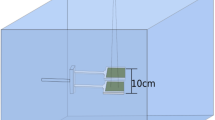Abstract
Cylindrical solid-walled steel electron collimators are used at the Royal Adelaide Hospital with a Siemens KD2 Mevatron accelerator to produce circular fields 2– 8 cm in diameter. The cones are used in contact with the patient’s skin. A flat treatment field is required at the treatment depth and the beam should also satisfy the uniformity standards as specified by the International Electrotechnical Commission (IEC). However, the seven and eight centimetre diameter cones provided by the manufacturer did not meet these specifications. In particular, the maximum dose relative to the depth-dose maximum on the central axis exceeded 126% as compared with the IEC recommended value of 109%, when used with a 21 MeV electron beam. Cone modifications were previously investigated by others with the results demonstrating some improvement in the ‘horn’ (as it appears on surface dose profiles) but still not satisfying IEC requirements. In the present paper the EGS4 code was used to model the existing treatment head geometry and cones, as well as new suggested modifications to the cone. The results of the simulation for the existing cone geometry corresponded closely to previously obtained measurements. The suggested collimator modifications involved a plastic insert along the internal wall of the collimator. Variations of the insert width and height were simulated for a 21 MeV electron beam and the results plotted to indicate the optimal insert dimensions. A plastic insert with the dimensions taken from one of the best models was produced and tested. The measurements showed close agreement with the simulation results (for the ‘horn’ height, dose within 1% and radial position within 2 mm) and improvement of the “maximum ratio of absorbed dose” from 126% before modification to 108% with the plastic insert. The tested insert was also simulated for a 12 MeV electron beam, to see whether permanent fitting of such an insert would have a deleterious effect at lower energies. Neither penetration nor flatness was significantly compromised, with a small penalty being a slight increase in the central axis dose near the surface.
Similar content being viewed by others
References
Webb, S., Evans, P.M., Swindell, W., and Deasy, J. O.A proof that uniform dose gives the greatest TCP for fixed integral dose in the planning target volume Phys. Med. Biol. 38, 2091–2098, 1994
Williams, T., Ebert, M., Keall, P., Haskard, D.Monte Carlo Simulation of Electron Cones used in Electron Beam Therapy, Australas. Phys. Eng. Sci. Med. 21, 112–119, 1998
Van der Laarse R., Bruinvis, I.A.D., Noonan, M. Farid.Wall-Scattering Effects in Electron Beam Collimation, Acta Radiol. Oncol. 17, 113–124, 1978
International Electrotechnical Commission, International Standard, IEC 976 and 977, Medical Electrical Equipment, 1st ed., 1989
Bova, F.J.,Clinical electron beam physics. From Radiation therapy physics edited by A.R. Smith, Springer-Verlag, 1995
Nelson, W.R., Hirayama, H., and Rogers, D.W.O.The EGS4 Code System, Stanford Linear Accelerator Center Publication 265, 1985
Lax, I., Brahme, A.Collimation of high energy electron beams. Acta Radiol. Oncol. 19, 199–207, 1980
Author information
Authors and Affiliations
Corresponding author
Rights and permissions
About this article
Cite this article
Northey, B.J., Zavgorodni, S.F. Optimisation of electron cone design in high energy radiotherapy using the Monte Carlo method. Australas. Phys. Eng. Sci. Med. 25, 7 (2002). https://doi.org/10.1007/BF03178369
Received:
Accepted:
DOI: https://doi.org/10.1007/BF03178369




